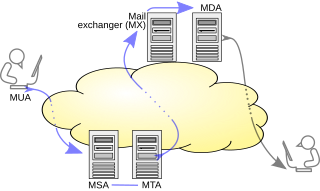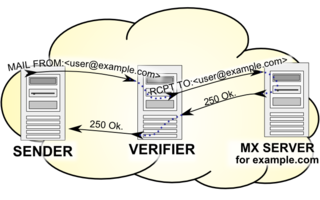The term list poisoning refers to poisoning an e-mail mailing list with invalid e-mail addresses.
The term list poisoning refers to poisoning an e-mail mailing list with invalid e-mail addresses.
Once a mailing list has been poisoned with a number of invalid e-mail addresses, the resources required to send a message to this list has increased, even though the number of valid recipients has not. If one can poison a spammer's mailing list, one can force the spammer to exhaust more resources to send e-mail, in theory costing the spammer money and time.
Poisoning spammers' mailing lists is usually done by blacklists submitting fake information to email submit style offers, or by posting invalid email addresses in a Usenet forum or on a web page where spammers are believed to harvest email addresses for their mailing lists.
This article's use of external links may not follow Wikipedia's policies or guidelines.(March 2022) |
A Domain Name System blocklist, Domain Name System-based blackhole list, Domain Name System blacklist (DNSBL) or real-time blackhole list (RBL) is a service for operation of mail servers to perform a check via a Domain Name System (DNS) query whether a sending host's IP address is blacklisted for email spam. Most mail server software can be configured to check such lists, typically rejecting or flagging messages from such sites.
A mailing list is a collection of names and addresses used by an individual or an organization to send material to multiple recipients. The term is often extended to include the people subscribed to such a list, so the group of subscribers is referred to as "the mailing list", or simply "the list".
A tarpit is a service on a computer system that purposely delays incoming connections. The technique was developed as a defense against a computer worm, and the idea is that network abuses such as spamming or broad scanning are less effective, and therefore less attractive, if they take too long. The concept is analogous with a tar pit, in which animals can get bogged down and slowly sink under the surface, like in a swamp.
Various anti-spam techniques are used to prevent email spam.

Email spam, also referred to as junk email, spam mail, or simply spam, is unsolicited messages sent in bulk by email (spamming). The name comes from a Monty Python sketch in which the name of the canned pork product Spam is ubiquitous, unavoidable, and repetitive. Email spam has steadily grown since the early 1990s, and by 2014 was estimated to account for around 90% of total email traffic.
Hashcash is a proof-of-work system used to limit email spam and denial-of-service attacks. Hashcash was proposed in 1997 by Adam Back and described more formally in Back's 2002 paper "Hashcash - A Denial of Service Counter-Measure". In Hashcash the client has to concatenate a random number with a string several times and hash this new string. It then has to do so over and over until a hash beginning with a certain amount of zeros is found.
Greylisting is a method of defending e-mail users against spam. A mail transfer agent (MTA) using greylisting will "temporarily reject" any email from a sender it does not recognize. If the mail is legitimate, the originating server will try again after a delay, and if sufficient time has elapsed, the email will be accepted.
A bounce message or just "bounce" is an automated message from an email system, informing the sender of a previous message that the message has not been delivered. The original message is said to have "bounced".
Email marketing is the act of sending a commercial message, typically to a group of people, using email. In its broadest sense, every email sent to a potential or current customer could be considered email marketing. It involves using email to send advertisements, request business, or solicit sales or donations. Email marketing strategies commonly seek to achieve one or more of three primary objectives: build loyalty, trust, or brand awareness. The term usually refers to sending email messages with the purpose of enhancing a merchant's relationship with current or previous customers, encouraging customer loyalty and repeat business, acquiring new customers or convincing current customers to purchase something immediately, and sharing third-party ads.
Kontact is a personal information manager and groupware software suite developed by KDE. It supports calendars, contacts, notes, to-do lists, news, and email. It offers a number of inter-changeable graphical UIs all built on top of a common core.
A spambot is a computer program designed to assist in the sending of spam. Spambots usually create accounts and send spam messages with them. Web hosts and website operators have responded by banning spammers, leading to an ongoing struggle between them and spammers in which spammers find new ways to evade the bans and anti-spam programs, and hosts counteract these methods.

A message submission agent (MSA), or mail submission agent, is a computer program or software agent that receives electronic mail messages from a mail user agent (MUA) and cooperates with a mail transfer agent (MTA) for delivery of the mail. It uses ESMTP, a variant of the Simple Mail Transfer Protocol (SMTP), as specified in RFC 6409.
Email harvesting or scraping is the process of obtaining lists of email addresses using various methods. Typically these are then used for bulk email or spam.
A webform, web form or HTML form on a web page allows a user to enter data that is sent to a server for processing. Forms can resemble paper or database forms because web users fill out the forms using checkboxes, radio buttons, or text fields. For example, forms can be used to enter shipping or credit card data to order a product, or can be used to retrieve search results from a search engine.
A spamtrap is a honeypot used to collect spam.
A challenge–response system is a type of that automatically sends a reply with a challenge to the (alleged) sender of an incoming e-mail. It was originally designed in 1997 by Stan Weatherby, and was called Email Verification. In this reply, the purported sender is asked to perform some action to assure delivery of the original message, which would otherwise not be delivered. The action to perform typically takes relatively little effort to do once, but great effort to perform in large numbers. This effectively filters out spammers. Challenge–response systems only need to send challenges to unknown senders. Senders that have previously performed the challenging action, or who have previously been sent e-mail(s) to, would be automatically receive a challenge.
A directory harvest attack (DHA) is a technique used by spammers in an attempt to find valid/existent e-mail addresses at a domain by using brute force. The attack is usually carried out by way of a standard dictionary attack, where valid e-mail addresses are found by brute force guessing valid e-mail addresses at a domain using different permutations of common usernames. These attacks are more effective for finding e-mail addresses of companies since they are likely to have a standard format for official e-mail aliases.

Callback verification, also known as callout verification or Sender Address Verification, is a technique used by SMTP software in order to validate e-mail addresses. The most common target of verification is the sender address from the message envelope. It is mostly used as an anti-spam measure.
Email spammers have developed a variety of ways to deliver email spam throughout the years, such as mass-creating accounts on services such as Hotmail or using another person's network to send email spam. Many techniques to block, filter, or otherwise remove email spam from inboxes have been developed by internet users, system administrators and internet service providers. Due to this, email spammers have developed their own techniques to send email spam, which are listed below.
A cold email is an unsolicited e-mail that is sent to a receiver without prior contact. It could also be defined as the email equivalent of cold calling. Cold emailing is a subset of email marketing and differs from transactional and warm emailing.